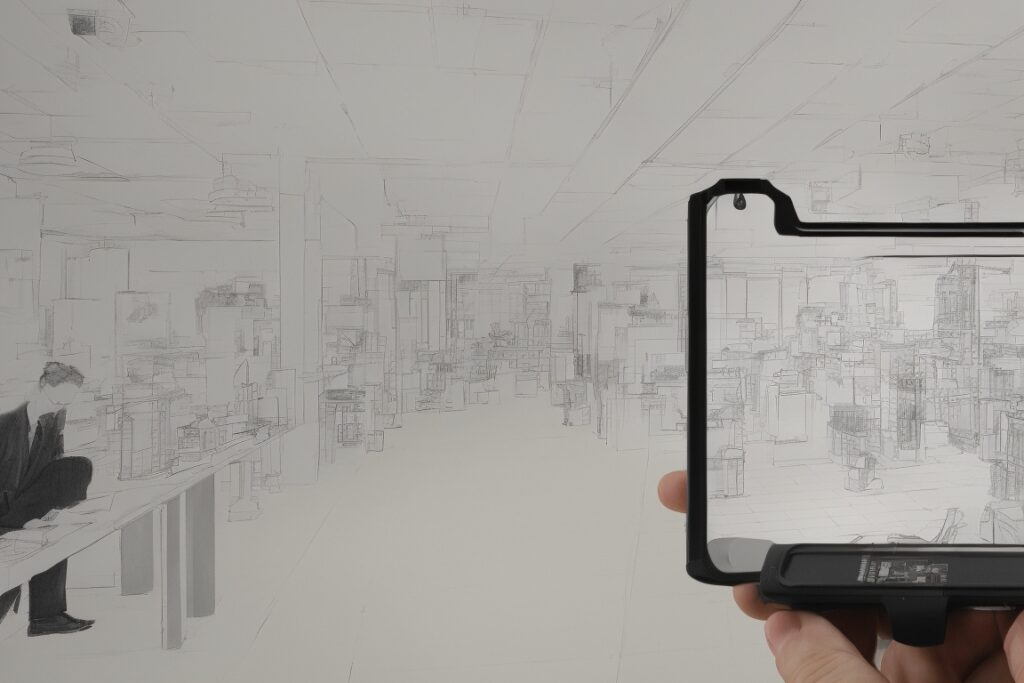Similar to businesses shifting online, marketing efforts have largely shifted online as well. Digital marketing strategies embrace a range of online tactics and channels brands use to promote their products and services. Search engine optimization (SEO), social media marketing, email marketing, content marketing, and pay-per-click (PPC) advertising are no longer innovative approaches. These are common practices integral to broader marketing concepts.
With that, competing in the digital realm gets harder and harder, and businesses seek new tactics to stand out from the crowd and connect with consumers more effectively. This is where Augmented Reality comes in as a functional tool to help digital marketers up their promotional game and reach new frontiers.
Understanding Augmented Reality in Digital Marketing
Augmented Reality (AR) or simulated reality is a technology that superimposes digital information, such as images, videos, or 3D models, onto the physical world. It’s typically viewed through a smartphone, tablet, or AR glasses. The primary goal of AR is to enhance the user’s perception of reality by mixing virtual elements into their surroundings. Thus, it allows users to interact with both real and virtual components simultaneously.
Basically, AR relies on computer vision, sensor data, and advanced algorithms to recognize and track real-world objects or surfaces to ensure the accurate placement and alignment of virtual content. This technology opens up a wide range of possibilities across various industries, from gaming and entertainment to education, retail, healthcare, commerce, and marketing.
However, it’s important to understand whether such a structure is right for your business. And to answer this question properly, it is better to contact strategic planning consultants. This will give you a clear understanding of which marketing direction you should take.

AR Evolution in Marketing
The first commercial application of AR in marketing emerged in the early 2000s. At that time, brands experimented with AR-enabled print ads and promotional campaigns. However, despite the overall excitement, the tech adoption remained limited due to technological constraints and a lack of consumer awareness.
The tech became a center of attention with the advent of smartphones and portable computing devices in the early 21st century. One of the key events was the introduction of ARKit by Apple and ARCore by Google. Developers were provided with powerful tools and frameworks to create quality simulations for iOS and Android devices.
AR apps like Pokemon Go demonstrated the mass appeal and potential of this technology. Marketers got interested and started exploring simulated reality as a means to enhance product experiences, offer interactive content, and drive foot traffic to physical locations.
Today, AR has outgrown the gaming and entertainment industries and morphed into a transformative instrument that found its use in multiple marketing sectors.

AR Impact on Customer Experience
At the core of AR popularity and its solid integration into digital marketing is how it influences customer experience. Currently, brands focus their promotional and commercial efforts on customers. Customer-centered approach and personalization are the name of the game when it comes to effective digital marketing strategies. AR reigns supreme in this concern.
The tech enables marketers to create captivating immersions tailored to customers’ personal preferences, interests, and behaviors to get prospects engaged and make them want to stay with the brand for longer. This is how brands can differentiate themselves in the competitive arena and win over customer attention to build long-lasting relationships and foster loyalty.
AR Benefits for Digital Marketing
AR has recently become a shining star of marketing instruments and for a good reason. With consumers widely favoring digital space for shopping, buying services, education, and communication, marketers have to quickly adapt to this new reality and master innovative practices of product and service promotions with digital means.
In this context, AR is a treasure trove of benefits for brands to boost sales and grow their customer base while confidently competing with their contenders and establishing a strong brand image.
Enhanced Customer Engagement and Retention
AR provides a dynamic and immersive experience that captures the attention of consumers in a way traditional marketing methods cannot. They can interact with products or services in a virtual environment that speaks to their imagination, evokes emotions, and lends some new kind of impressions.
Customers feel curious, excited, and cared for at the same time as if it was made for each of them individually. AR creates a new level of prospect engagement which is much deeper and much more personalized. Through such memorable experiences, businesses can forge emotional connections that live longer, nurture consumer dedication to the brand, and encourage repeat interactions.
Boosting Brand Awareness
It’s vital for businesses to stand out In a crowded digital marketplace. However, it’s not easy to get noticed, to say nothing about getting in the spotlight. AR offers a unique platform for brands to showcase their products or services in a visually compelling and interactive manner that catches customer’s eye and is easy to perceive. Through simulated reality experiences, businesses can captivate their audience’s attention and effectively convey their brand message. By leveraging AR capabilities and smartly building them in their promotion strategies, brands can differentiate themselves, drive brand awareness, and create a lasting impression in the minds of consumers.
Extended Market Reach
With nearly 7 billion smartphone users worldwide, AR-enabled marketing campaigns have the potential to reach a vast global audience. Traditional marketing channels are limited by geographical boundaries. Meanwhile, AR transcends physical barriers and allows businesses to connect with consumers wherever they are. Companies can employ mobile apps, social media platforms, or web-based simulations to extend their market reach and engage with customers on a global scale. It will help them drive brand recognition and expand their customer base.
Improved Brand Exposure
In the world of marketing, generating buzz is about being noticed and standing at the frontline. AR experiences have the power to produce buzz and draw the attention of media outlets, influencers, and social media users.
Innovative AR campaigns allow brands to garner organic exposure and virality. They can amplify their visibility across various digital platforms using branded AR filters, interactive AR installations, or simulation-infused challenges to embrace the inherently shareable nature of AR experiences. All of this will work to increase brand exposure, spark conversations, and create valuable user-generated content that contributes to brand credibility and reach.
Stimulating Purchase Decisions
In an online market that abounds with propositions, making a quick choice is not an easy task. Customers often feel lost, unconfident, and unable to make a decision. One of the key benefits of AR in digital marketing is its ability to facilitate informed purchases.
The tech allows customers to visualize products in real-world environments. Thus, it bridges the gap between online browsing and offline shopping, reducing uncertainty and hesitation in the purchase process. AR instills confidence and promotes well-reasoned decisions, minimizing purchase anxiety, driving conversion rates, and increasing sales.
Reduced Marketing Expenses
While tech tools seem expensive, the reality is a bit different. Compared to traditional marketing channels, AR offers more cost-effective promotion. With AR on their side, businesses can
- Streamline their marketing efforts;
- Cut down production costs associated with physical prototypes or traditional advertising materials; and
- Achieve a higher return on investment.
On top of that, AR campaigns are easy to scale and adapt for different platforms and audiences, maximizing reach and impact while further minimizing expenses.
Increasing Sales
The goal of marketing efforts is revenue and sales growth. AR can become a real find in this domain. Online simulations are hard to resist. While helping make informed choices, they drag customers in and push them to impulse purchases, thus, boosting sales conversions. Along the way, AR showcases complementary products or personalized recommendations on customer preferences, thus, facilitating upselling and cross-selling. This multi-tier approach results in higher order values and sales revenue bump-up.
Minimizing Returns
Offering convenience and flexibility to customers, online commerce entails the problem of returns that add to operational costs and slow down product circulation. This happens due to poor product visualization and the reality of falling behind customer expectations.
AR enables more accurate product representations and even lets customers visualize products in realistic environments. As a result, it
- Reduces the likelihood of mismatched expectations;
- Enhances the overall shopping experience
- Minimizes returns;
- Increases customer satisfaction rates;
- Cuts down operational costs associated with returns processing and restocking.
Breaking Barriers
AR has the potential to break down barriers between online and offline shopping. It establishes hassle-free omnichannel experiences for consumers. By bridging the gap between the digital and physical worlds, organizations can provide customers with convenient, personalized, and accessible shopping that caters to their preferences and needs.
Brands can use AR-enabled mobile apps, interactive in-store displays, or virtual showrooms to create cohesive experiences that transcend traditional retail boundaries. This allows for driving engagement and loyalty across all touchpoints in the customer journey.
Uplifting Social Media Marketing
Social media have eagerly implemented AR-powered filters, lenses, and effects to offer users interactive and shareable experiences. Companies can incorporate exclusive AR experiences into their social media promotions to boost user engagement, magnify brand visibility, and leverage user-generated content to naturally reach new audiences. AR filters and effects encourage social media users to interact with branded content, share their experiences with their networks, and participate in viral challenges and campaigns. This results in elevated brand awareness, increased reach, and enhanced brand advocacy among target audiences.
Improved Customer Service
AR technology can enhance customer service by providing virtual assistance, interactive tutorials, and troubleshooting guides. AR-based product demonstrations, installation guides, and assembly instructions can empower consumers with self-service solutions that improve their overall shopping experience and satisfaction.
Companies can provide customers with access to helpful AR tools and resources to
- Reduce the need for in-person assistance;
- Streamline support processes;
- Resolve customer issues more efficiently;
- Enhancing brand loyalty.

Using AR in Digital Marketing
With a whole bunch of benefits to it, AR is undoubtedly a powerful marketing tool that can be used in different ways to help brands coin new more functional and efficient strategies tailored to their specific business goals and immediate needs.
Trying Before Buying
Simulated reality enables consumers to virtually try out products in real-world settings. It works to mitigate the uncertainty associated with online shopping. Retailers can develop AR apps that allow users to lay virtual objects, such as furniture, clothing, or beauty products, onto their surroundings using their smartphone camera. Thus, customers can visualize how products would look or fit in their homes or on their bodies, leading to more informed purchase decisions and reduced returns.
Virtual Touring
AR-powered virtual tours offer an immersive way for consumers to explore destinations, accommodations, and attractions remotely. Businesses in the travel and hospitality sectors can create apps that provide users with interactive 360-degree views, detailed information, and even virtual guides. While enhancing the pre-travel experience, a glimpse into the actual ambiance of rooms, cruise ships, and tourist sites also helps in inspiring travel plans and promoting bookings.
Augmented Branding Materials
Using AR, marketers can breathe new life into traditional marketing materials like business cards, brochures, and packaging. AR markers or codes embedded within these materials enable brands to offer interactive experiences to users. For example, a business card equipped with AR markers can trigger a virtual presentation, product demonstration, or a 3D model of the company’s flagship product when scanned using a smartphone or tablet. It will grab the recipient’s attention and enhance brand recall while creating a lasting impression.
Gamification for Brand Engagement
Gamification involves integrating game mechanics and elements into non-game contexts, such as marketing campaigns, to drive engagement and participation. AR’s interactive and immersive nature makes this tech a no-brainer for gamification strategies. Brands can come up with simulated reality games, quizzes, challenges, or scavenger hunts that users can participate in through mobile apps or social media filters. Through rewards, incentives, or competitions, companies can foster deeper engagement, increase brand awareness, and encourage user-generated content sharing.
Location-Based AR Marketing
This approach takes advantage of geolocation data to deliver contextually relevant experiences to users based on their physical location. Brands can deploy simulations tied to specific locations, such as landmarks, events, or retail stores. For instance, a restaurant might use AR to display menu specials when users scan its storefront, enticing them to step inside and dine. Likewise, retailers can deploy apps that provide personalized offers, product recommendations, or virtual try-ons when users are within proximity of their storefronts.
AR-Powered Storytelling
AR enhances storytelling by adding layers of interactivity and immersion to narratives.
Brands can leverage the tech to tell compelling stories that captivate and emotionally resonate with audiences. For example, museums and historical sites can overlay digital reconstructions, animations, or interactive exhibits onto physical artifacts, bringing history to life dynamically and engagingly. Similarly, businesses can create exciting simulations at events, activations, or in-store displays to immerse customers in branded narratives to amplify brand affinity and stimulate memorable interactions.

How to Implement AR in Digital Marketing?
At this point, the power of AR in digital marketing is undeniable and its perspectives are far-reaching. Yet, to benefit from all those goodies simulated reality can offer, you should be able to properly implement it. So, where to start from? How to make AR a part and parcel of your marketing tactics? Here is a quick step-by-step guide to help you adopt a structured approach.
- Analyze and Segment Your Target Audience
An efficient marketing strategy starts with knowing your audience. You should understand your prospects, their preferences, purchasing behaviors, and demographics to nail approaches that will work for them. Conduct market research, analyze customer data, and segment your audience based on these criteria. This info will help tailor your AR experiences to meet the specific needs and aspirations of different customer groups.
- Set Clear Objectives and KPIs
The next step is to define your goals and outline key performance indicators for your AR-enabled campaigns to see where you need to move and understand what you should do. You might aim to increase brand awareness, drive sales, or enhance customer engagement. Whatever your goal, measurable targets will guide your campaign strategy and enable you to track progress effectively.
- Collaborate With Developers and Tech Partners
Engage experienced AR professionals to bring your ideas to life. Work closely with tech engineers to leverage their expertise in AR design, development, and implementation. Consider partnering with technology providers who offer AR platforms or solutions that align with your marketing objectives and budget.
- Create Engaging AR Experiences
It’s a designing stage where you should plan your AR efforts and create experiences that will match your business sphere, activity, and marketing goals. You can choose between product demonstrations, virtual try-ons, gamified experiences, interactive tutorials, social media virtual effects, and more. All of these methods stimulate interaction, promote engagement, build customer trust, and encourage purchase.
- Integrate With Existing Digital Marketing Channels
One of the best things about AR is its integration capability enabling you to keep using habitual digital marketing channels while boosting their efficiency. You can embed AR experiences into your social media marketing efforts to drive traffic to your digital platforms. Create AR filters, lenses, or effects for popular social media platforms like Instagram, Snapchat, or Facebook to reach a wider audience.
If you use an e-commerce website or app, introduce AR features to let customers preview products in AR, visualize customization options, or receive personalized recommendations based on their preferences.
Finally, develop standalone mobile apps or integrate AR functionality into your existing apps. Ensure compatibility across different devices and operating systems to reach a diverse audience.
- Measure and Optimize Your Campaigns
You should consistently keep an eye on your AR-driven campaigns to be able to identify weaknesses and make adjustments along the way. So, monitor user engagement metrics such as interaction time, clicks, shares, and conversions. Use analytics tools to track user behavior patterns and detect areas for improvement.
Conduct A/B testing to compare different variations of your AR experiences and optimize performance based on user feedback and data insights. Continuously iterate and refine your efforts, approaches, and concepts to achieve your marketing goals.
Future Trends and Opportunities to Watch For
Standing strong enough to reshape the digital marketing landscape, AR keeps evolving at a rapid pace, with new promising opportunities for business yet to come. Let’s take a quick look at the major upcoming trends.
- Advancements in AR Tech and Hardware: We can expect to see improvements in hardware capabilities, such as enhanced camera sensors, more powerful processors, and lighter and more comfortable AR glasses. These advancements will enable even more realistic and seamless AR experiences to further push the boundaries of what is possible in digital marketing;
- Web-AR and Cloud-Based AR Solutions: WebAR gains traction as a convenient and accessible way to deliver AR experiences directly through web browsers. This will eliminate the need for users to download dedicated apps. With the rise of cloud-based solutions, businesses can make use of cloud computing resources to offload processing tasks and create more sophisticated AR experiences for users. This shift will ease access to AR technology, making it more accessible to businesses of all sizes;
- AR Integration With IoT and AI: AI-powered algorithms can enhance simulations through personalized recommendations, real-time object recognition, and natural language processing capabilities. Similarly, IoT devices can enrich simulations by providing contextual information and enabling flawless interaction with connected smart devices. Such integrations will lead to more intelligent and contextually relevant marketing experiences.
To provide business agility, we recommend you go for cloud consulting services. This will help you design and optimize your investments.
Final Thought
To sum up, Augmented Reality is certainly a game-changer in the world of digital marketing that brings online promotional strategies to a new level. Businesses should understand its capabilities, embrace its potential, and leverage its transformative impulse to position themselves at the forefront of innovation and be able to shape the future of marketing. The time to employ AR is now, and the opportunities it presents are limitless.


